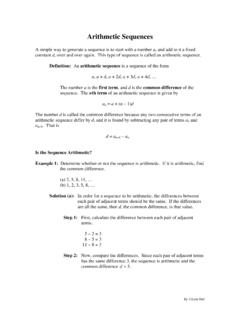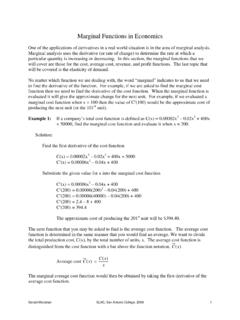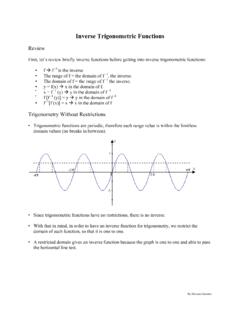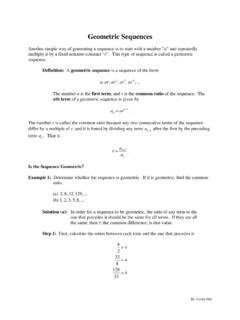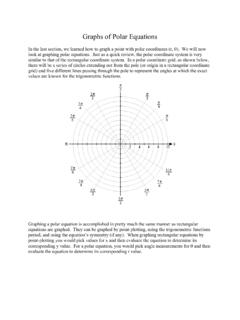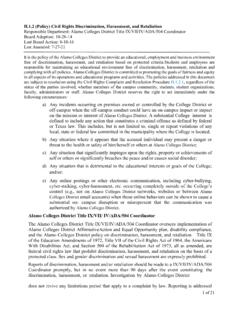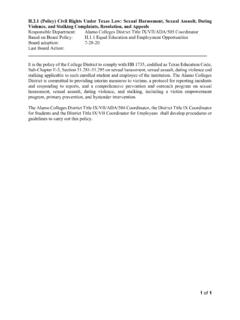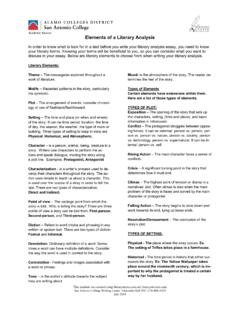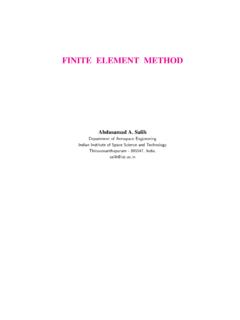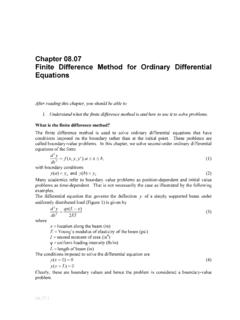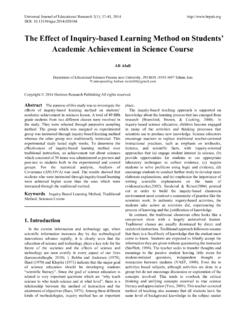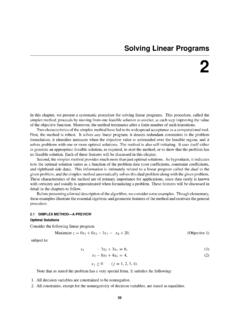Transcription of SUM AND DIFFERENCE FORMULAS - Alamo Colleges District
1 SUM AND DIFFERENCE FORMULAS . Introduction We have several identities that we are concentrating on in this section: o DIFFERENCE Identities for Cosine o Sum Identities for Cosine o Cofunction Identities o DIFFERENCE Identities for Sine and Tangent o Sum Identities for Sine and Tangent Instead of just having one variable like in the basic identities, two variables are involved in the identities of this section. DIFFERENCE Identities for Cosine Equation No. 1: cos (x y) = (cos x)(cos y) + (sin x)(sin y). This is the DIFFERENCE identity for cosine To prove the equation above, the unit circle below assumes that x and y are within the interval (0, 2 ) and x > y > 0.
2 All real numbers and angles in radian or in degrees are represented by periodicity and basic identities. The angles and arcs on the unit circle are to associate x and y. Labeling the points are done by using the definitions of the trigonometric functions (sine, cosine, tangent, cotangent, cosecant, and secant), in this case only sine and cosine are utilized. by Shavana Gonzalez Establishing the DIFFERENCE Identity for Cosine If the triangle AOB, rotates clockwise about the origin until point A coexists with point D, then point B will be where point C is located on the unit circle. Since the rotations retains lengths: d (A, B) = d (C, D). (c a) + ( d b) (1 e ) + ( 0 f ).
3 2 2 2 2. =. (c a)2 + (d b)2 = (1 e)2 + f 2. c2 2ac + a2 + d2 2db + b2 = 1 2e + e2 + f 2. Equation No. 2: (c2 + d2) + (a2 + b2) - 2ac 2db = 1 2e + (e2 + f 2). Considering the fact that points A, B, and C are on the unit circle: c 2 + d 2 = 1, a 2 + b 2 = 1, and e2+f 2 =1. equation no. 2, boils down to: e = ac + bd Ok, I know what you are thinking, all of these letters and what does it have to do with cos (x y) = (cos y)(cos x) + (sin y)(sin x). Well, let's put the equations together now by replacing e, a, c, b, and d with cos (x y), cos y, cos x, sin y, and sin x, respectively: by Shavana Gonzalez Establishing Continues . e = ac + bd cos (x y) = (cos y)(cos x) + (sin y)(sin x).
4 Cos (x y) = (cos x)(cos y) + (sin x)(sin y). Now, we have established the DIFFERENCE identity for cosine. Sum Identity for Cosine In order to achieve the sum identity, we replace y with y on the DIFFERENCE equation (cos x)(cos y) + (sin x)(sin y). Then, use the identities for negatives [cos (-y) = cos y; sin (-y) = -sin y], we obtain: cos (x + y) = (cos x)(cos y) (sin x)(sin y).. The Sum Identity for Cosine Note: cos (x y) cos x cos y cos (x + y) cos x + cos y Cofunction Identities From the DIFFERENCE identity for cosine equation, we are going to attain the cofunction identities for cosine, sine, and tangent. First we take the DIFFERENCE identity: cos (x y) = (cos x)(cos y) + (sin x)(sin y).
5 Let x = /2: cos ( /2 y) = (cos /2)(cos y) + (sin /2)(sin y). Then, we find that cos /2 = 0, and sin /2 =1, according to the Unit Circle, therefore: cos ( /2 y) = (0) cos y + (1) sin y = sin y cos ( /2 y) = sin y . We have established the Cofunction identity for Cosine. For y any real number or radian measure. Replace /2 with 90 degrees, if y is measured in degrees. by Shavana Gonzalez Cofunction Identities, Continued . We have the cosine taken care of, now let us do the cofunction identity for sine. First we take the cofunction identity for cosine: cos ( /2 y) = sin y Then, we let y = /2 x: cos ( /2 ( /2 x)) = sin ( /2 x). cos ( 0 + x) = sin ( /2 x).
6 Cos x = sin ( /2 x). sin ( /2 x) = cos x . Cofunction identity for sine For any real number x or radian measure. Replace /2 with 90 degrees if x is in degree measure. Cofunction Identities Conclusion . The cofunction for tangent is: tan ( /2 x ) = cot x Where x is any real number or radian measure. Replace /2 with 90 degrees, if x is in degree measure. To conclude: o cosine, cotangent, and cosecant are basically cofunctions of sine, tangent, and secant, respectively. o Basically, cosine, cotangent, and cosecant means, complements sine, tangent, and secant, respectively. o When, 0 < x < 90 degrees, then x and 90 x are complementary angles. Now that we have the cofunction identities in place, we can now move on to the sum and DIFFERENCE identities for sine and tangent.
7 DIFFERENCE Identity for Sine To arrive at the DIFFERENCE identity for sine, we use 4 verified equations and some algebra: o cofunction identity for cosine equation o DIFFERENCE identity for cosine equation o cofunction identity for sine equation o the identities for negatives by Shavana Gonzalez DIFFERENCE Identity for Sine (Continued ). First, use the cofunction identity for cosine : cos ( /2 y) = sin y . sin (x - y) = cos [ /2 (x - y)]. Second, we apply algebra: sin (x - y) = cos [( /2 x) (-y)]. Third, use the DIFFERENCE identity for cosine equation: cos (x y) = (cos x)(cos y) + (sin x)(sin y).. cos (x y) = cos ( /2 x) cos (-y) + sin ( /2 x) sin (-y).
8 Finally, use cofunction identity for cosine and sine, also the identities for negatives: cos ( /2 y) = sin y ; sin ( /2 x) = cos x ; sin (-x) = -sin x; cos (-x) = cos x . sin (x y) = (sin x)(cos y) (cos x)(sin y) DIFFERENCE Identity for Sine Sum Identity for Sine To obtain the sum identity for sine, we replace y with y in the DIFFERENCE identity for cosine equation, as follows: sin (x (-y)) = (sin x)(cos (-y)) (cos x)(sin (-y)).. sin (x + y ) = (sin x)(cos y) + (cos x)(sin y). (identities for negatives was utilized to derive the sum identity for sine equation). DIFFERENCE & Sum Identity for Tangent To attain the DIFFERENCE identity for tangent, we use both sine and cosine DIFFERENCE identities: sin( x y ).
9 Tan( x y ) =. cos( x y ). =. ( sin x )( cos y ) ( cos x )( sin y ). ( cos x )( cos y ) + ( sin x )( sin y ). by Shavana Gonzalez take the numerator and denominator and divide it by cos x cos y tan( x y ) =. ( sin x )( cos y ) ( cos x )( sin y ). ( cos x )( cos y ) + ( sin x )( sin y ). ( sin x )( cos y ) ( cos x )( sin y ). =. ( cos x )( cos y ). ( cos x )( cos y ) + ( sin x )( sin y ). ( cos x )( cos y ). algebraic operations are applied ( sin x )( cos y ) ( cos x )( sin y ). tan( x y ) =. ( cos x )( cos y ). ( cos x )( cos y ) + ( sin x )( sin y ). ( cos x )( cos y ). ( sin x sin y ). =. ( cos x )( cos y ). 1+. ( sin x )( sin y ). ( cos x )( cos y ).
10 ( sin x sin y ). tan( x y ) =. ( cos x )( cos y ). 1+. ( sin x )( sin y ). ( cos x )( cos y ). tan x tan y =. 1 + ( tan x )( tan y ). DIFFERENCE Identity for Tangent To obtain the sum identity, we replace every y with y in the equation above: tan x tan y tan( x y ) =. 1 + ( tan x )( tan y ). tan x tan ( y ). tan( x ( y )) =. 1 + ( tan x ) ( tan ( y ) ). tan x + tan y tan( x + y ) =. 1 ( tan x )( tan y ). Sum Identity for Tangent by Shavana Gonzalez Example 1 ( DIFFERENCE Identity): Simplify sin (x /2). Answer Let's simplify sin (x /2), using the DIFFERENCE identity, sin (x y) = (sin x)(cos y) (cos x)(sin y). sin (x /2) = (sin x)(cos /2) (cos x)(sin /2).
